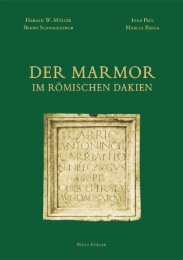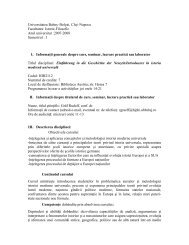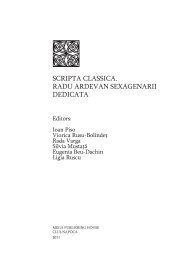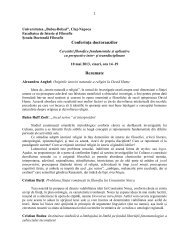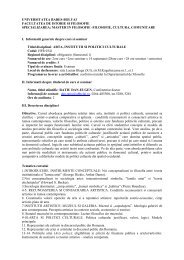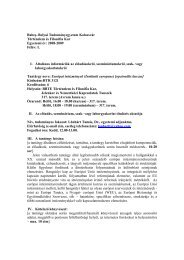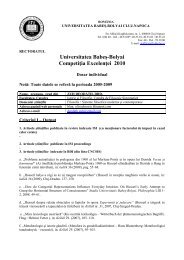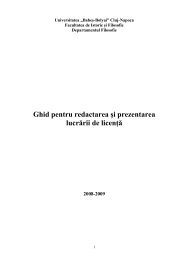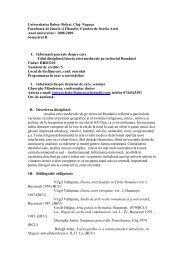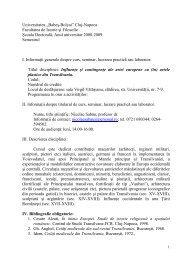transylvanian review
transylvanian review
transylvanian review
You also want an ePaper? Increase the reach of your titles
YUMPU automatically turns print PDFs into web optimized ePapers that Google loves.
TRANSYLVANIAN REVIEW<br />
Vol. XXI, Supplement No. 2, 2012<br />
Institutional Structures<br />
and Elites in Sãlaj Region<br />
and in Transylvania<br />
in the 14 th –18 th Centuries<br />
Edited by<br />
ANDRÁS W. KOVÁCS<br />
Linguistic editor:<br />
EMESE CZINTOS
ROMANIAN ACADEMY<br />
Chairman:<br />
Academician Ionel Haiduc<br />
CENTER FOR<br />
TRANSYLVANIAN STUDIES<br />
Director:<br />
Academician Ioan-Aurel Pop<br />
Publication indexed and abstracted in the<br />
Thomson Reuters Social Sciences Citation Index ® ,<br />
in Social Scisearch ® and in the Journal Citation<br />
Reports/Social Sciences Edition,<br />
and included in EBSCO’s and ELSEVIER’s products.<br />
On the cover:<br />
The coat of arms from 1418 of the Csese (Kese) of Dans and<br />
of Keresztúr family, inherited later by the Wesselényi family<br />
(National Archives of Hungary, Collection of pre-1526<br />
charters, DL 105473). Photo by ERIKA CZIKKELYNÉ NAGY.<br />
Maps by BÉLA NAGY<br />
This work was supported by CNCSIS-UEFISCSU, project<br />
number PN II-RU code/2010. Title of the research project:<br />
Institutional Structure and Elites in Sãlaj Region in the<br />
14 th –17 th Centuries (Structuri instituþionale ºi elite<br />
din Þara Silvaniei în secolele XIV–XVII), code: TE_204.<br />
Transylvanian Review continues the<br />
tradition of Revue de Transylvanie,<br />
founded by Silviu Dragomir, which<br />
was published in Cluj and then in Sibiu<br />
between 1934 and 1944.<br />
Transylvanian Review is published<br />
4 times a year by the Center for<br />
Transylvanian Studies and the<br />
Romanian Academy.<br />
EDITORIAL BOARD<br />
CESARE ALZATI, Ph.D.<br />
Facoltà di Scienze della Formazione, Istituto<br />
di Storia Moderna e Contemporanea,<br />
Università Cattolica, Milan, Italy<br />
HORST FASSEL, Ph.D.<br />
Institut für donauschwäbische Geschichte<br />
und Landeskunde, Tübingen, Germany<br />
KONRAD GÜNDISCH, Ph.D.<br />
Bundesinstitut für Kultur und Geschichte<br />
der Deutschen im östlichen Europa,<br />
Oldenburg, Germany<br />
HARALD HEPPNER, Ph.D.<br />
Institut für Geschichte, Graz, Austria<br />
PAUL E. MICHELSON, Ph.D.<br />
Huntington University, Indiana, USA<br />
ALEXANDRU ZUB, Ph.D.<br />
Chairman of the History Section of the<br />
Romanian Academy, Director of the A. D.<br />
Xenopol Institute of History, Iaºi, Romania<br />
EDITORIAL STAFF<br />
Ioan-Aurel Pop Virgil Leon<br />
Nicolae Bocºan Daniela Mârza<br />
Ioan Bolovan Vasile Sãlãjan<br />
Raveca Divricean Alexandru Simon<br />
Maria Ghitta Nicolae Sucalã-Cuc<br />
Rudolf Gräf<br />
Translated by<br />
Bogdan Aldea—English<br />
Liana Lãpãdatu—French<br />
Desktop Publishing<br />
Edith Fogarasi<br />
Cosmina Varga<br />
Correspondence, manuscripts and books<br />
should be sent to: Transylvanian Review,<br />
Centrul de Studii Transilvane<br />
(Center for Transylvanian Studies)<br />
12–14 Mihail Kogãlniceanu St.,<br />
400084 Cluj-Napoca, Romania<br />
cst@acad-cluj.ro<br />
www.centruldestudiitransilvane.ro
Contents<br />
• Editors’ Note 5<br />
• Institutional Structures and Elites in Sãlaj Region in the 14th –17th Centuries 7<br />
Editing and Publishing Historical Sources in the Research Institute<br />
of the Transylvanian Museum Society 9<br />
Tamás Fejér<br />
The Authorities of Middle Solnoc and Crasna Counties in the Middle Ages 31<br />
András W. Kovács<br />
The Affiliation of Medieval Sãlaj (Szilágy) Region in the Mirror of Social Relations 67<br />
Géza Hegyi<br />
• Institutional Structures and Elites in Transylvania in the 15th –18th Centuries 101<br />
Remarks on the Careers of the Vice-voivodes of Transylvania<br />
in the Late Middle Ages (1458–1526) 103<br />
András W. Kovács<br />
Transylvanian Places of Authentication and Ecclesiastical Intellectuals<br />
in the Middle Ages 139<br />
Emøke Gálfi<br />
Remarks on the Activity of the Cluj-Mãnãºtur Place of Authentication<br />
in the Age of the Transylvanian Principality 155<br />
Zsolt Bogdándi<br />
Fortress-Building in 16th-Century Transylvania. The Recruitment of Labour Force 163<br />
Klára P. Kovács<br />
The Inquisitors in the Judicial Practice of Cluj at the End of the 16th Century 181<br />
László Pakó<br />
The Manorial Court of the Reformed Parish of Cluj (1676–1695) 199<br />
Anikó Szász<br />
The Lord my God Has Given My Wife a Child.<br />
Childbirth in 18th-Century Transylvania 221<br />
Andrea Fehér<br />
The Local Exercise of Power in Sãtmar county at the Beginning of the 18th Century 237<br />
Judit Pál<br />
• List of Authors 252
The Local Exercise of Power<br />
in Sãtmar county<br />
at the Beginning of the 18 th Century*<br />
JUDIT PÁL<br />
The patron-client relation<br />
HISTORIOGRAPHY HAS dealt extensively with the development of the<br />
bureaucracy in the eighteenth century, 1 but there is still little information<br />
on the exercise of power on the local level. The functioning of institutions<br />
cannot be fully grasped without understanding the functioning of personal<br />
relations, especially not under the circumstances when the underdeveloped<br />
bureaucracy – with its low number of civil servants and very limited resources<br />
– had to face a complex set of relations and, what is more, a “feral” world which<br />
resembled Eastern Hungary in the wake of the defeat of the rebellion led by<br />
Francis Rákóczi II.<br />
In the analysis of the development of the state and bureaucratization process<br />
in the early-modern period, the patron-client relation can serve as a useful theoretical<br />
model. 2 The role of the patron-client relations was often emphasized when dealing<br />
with the development of the early-modern state as well as the administration.<br />
At the time, loyalty was not yet an abstract bureaucratic loyalty, but it was<br />
much more linked to personal ties. Without the latter, in the early-modern period,<br />
it would have been very difficult to rule the state and operate offices, or even<br />
borrow money and obtain information. 3 As Wolfgang Reinhard argues: “the earlymodern<br />
patron-client relations constitute that system of the socially-accepted and<br />
morally-founded micro-political behaviour patterns, which is at the same time<br />
considered as the emblematic blueprint of the cultural politics of early-modern<br />
Europe.” 4<br />
There was certain debate surrounding this concept, some having a too wide<br />
perception of it, 5 while others drawing the attention to its pitfalls. 6 Demarcation<br />
* This work was supported by CNCS-UEFISCDI, project number: PN-II-PCE-2011-<br />
3-0040.
238 • TRANSYLVANIAN REVIEW • VOL. XXI, SUPPLEMENT NO. 2 (2012)<br />
always entails difficulties, it is not easy for instance to separate it from the kinship<br />
relations. The patron-client relation was multifaceted, its forms of manifestation<br />
being typical of a certain country or region. These relations became pervasive<br />
almost all over Europe, being present at Courts, universities, towns, the papal<br />
curia, cloisters; moreover, Reformation also spread by means of these channels<br />
(according to certain sources, Luther was one of the most efficient patrons). 7<br />
In Central-Eastern Europe, the phenomenon was firstly and more thoroughly<br />
analyzed by the Polish historiography. In the eighteenth century virtually the<br />
entire Polish-Lithuanian nobility was pervaded by the patron-client relations. 8<br />
One of the basic features of the patron-client relations is mutuality as well<br />
as asymmetry and inequality: it is about such an asymmetrical type of relationship<br />
in which the individual with a more prominent social status offers certain advantages<br />
to his client through his prestige, economic possibilities and connections, while<br />
the latter “reciprocates” with other services. However, the relation between patrons<br />
and clients went beyond material exchanges, being also characterized by immaterial<br />
factors such as service and loyalty. An important aspect is the consensus between<br />
the partners, the voluntarism from the part of the client without which the nature<br />
of the relation would be different. The patron-client relation has manifold forms,<br />
albeit it is generally characterized by durability. The stronger the hierarchy and<br />
the smaller the mobility is within a society, the more stable and lasting is the<br />
patron-client relation. However, we should keep in mind that at this point we are<br />
dealing with social roles: somebody could be patron in one social order and client<br />
in another.<br />
Patrons played a significant role in the obtainment of offices. Helping relatives<br />
and clients obtain offices counted as a social responsibility. One of the most<br />
important – if not the most important – aspect of a career was the identification<br />
of the right patron and the development of personal relations. Ultimately, social<br />
networks also facilitated mobility. Even if bureaucratic rules were in place, they<br />
were too weak to serve as general norms. Personal relations played a much greater<br />
role than formal rules in the management of bureaucratic issues. As Valentin<br />
Grobner argues, in the early-modern period there was not so much a gap or a<br />
precipice between bureaucratic norms and practices, but rather a space where<br />
those who held bureaucratic positions moved and which they used according<br />
to their logic. 9 The micro-historical researches on the early-modern era also indicate<br />
that there was no entirely coherent and structured norm system, and that the<br />
social actors used the cracks in the system to manipulate the norms and give<br />
various interpretations to the rules for their own interests.<br />
Our sources do no allow us to reconstruct entire social networks, but the<br />
revelation of some of their aspects can take us closer to answering the question<br />
regarding the role that the patron-client relation played within the exercise of
INSTITUTIONAL STRUCTURES AND ELITES IN TRANSYLVANIA IN THE 15 TH–18 TH CENTURIES • 239<br />
power on the local level. Below, I will analyze such a “mediator” from the early<br />
eighteenth century, who acted simultaneously on several levels: he played some<br />
sort of mediating role between the town council, the state power, and the Károlyi<br />
aristocratic family.<br />
The location: Eighteenth-century Satu-Mare<br />
SATU-MARE WAS the longest-held territory by the kuruc army; its fortress<br />
was an important strategic point, thus suffering extensive damage on several<br />
occasions during the freedom fight led by Francis Rákóczi II. After the<br />
burning of the town the local inhabitants fled, and only slowly returned to<br />
their homes. According to a census conducted around the time of the Treaty of<br />
Satu-Mare, the town had a total of 101 citizens and 42 cottars, while the number<br />
of empty dwellings reached 169.<br />
Despite the devastation, the town council took advantage of the situation<br />
in order to obtain the status of free royal town, which it had tried to obtain on<br />
several occasions before, but failed. After persistent efforts, their attempt was<br />
finally successful: the status of free royal town of Satu-Mare (Szatmárnémeti) was<br />
legally enacted in 1722. However, the expenses that accompanied the obtainment<br />
of the new status as well as the corresponding redemption of fiscal possessions<br />
and smaller royal usufructuary rights surpassed the financial possibilities of the<br />
town and finally led to its indebtedness. Furthermore, mostly due to the<br />
aforementioned problems, the town council also came into conflict with one<br />
of the most prominent landlords in the region and the Lord Lieutenant (føispán)<br />
of the county, Sándor Károlyi. He was disturbed by the town’s efforts for<br />
independence not only as Lord Lieutenant, but also as the owner of the two<br />
manors and one of the pubs belonging to them, over which a bitter dispute started<br />
between him and the town. The rights over the pub was the most sensitive<br />
issue in the dispute, but other thorny issues arose as well. Both parties used every<br />
strategy in the conflict, from intelligence gathering to the bribery of officials, and<br />
they also tried to mobilize all their personal connections. Károlyi also had a trusted<br />
person within the town, the tricesimator (collector of the one-thirtieth tax) Gábor<br />
Erøs from Satu-Mare, who provided him with valuable information. 10
240 • TRANSYLVANIAN REVIEW • VOL. XXI, SUPPLEMENT NO. 2 (2012)<br />
The two “main characters”:<br />
Sándor Károlyi and Gábor Erøs<br />
SÁNDOR KÁROLYI (1669–1743) was Francis Rákóczi II’s general and trusted<br />
man, but he was able to erase his kuruc 11 past due to his role in the conclusion<br />
of the Treaty of Satu-Mare (1711). His career progressed afterward, and<br />
in 1712 he was awarded the title of Count. In the meantime he also significantly<br />
increased his wealth. In 1708, Rákóczi II pledged to him the landed estate in<br />
Erdød, which had previously been in the property of the Treasury. In 1720, he<br />
managed to obtain a royal letter of donation for the estate. He continued to<br />
acquire new estates, and due to his manifold financial transactions he managed<br />
to extend their surface considerably, paying great attention to their organization<br />
and rendering them economically viable. After the Treaty of Satu-Mare, he remained<br />
one of the leading political figures in Hungary, playing an important role in<br />
the Diet of 1712–15 and later becoming a councillor at the re-established Royal<br />
Council of Governors (Helytartótanács). 12 Károlyi – a gifted man with a strong<br />
personality – succeeded in developing an extensive network of clients as well. 13<br />
In his capacity as Lord Lieutenant of Sãtmar County he always paid close attention<br />
to the management of the county’s affairs. Actually, the Károlyi family was the<br />
only truly powerful aristocratic family whose wealth and social connections<br />
expanded well beyond the borders of the County.<br />
We have little information on the origins of Gábor Erøs, but we know for<br />
certain that he was a nobleman. In the seventeenth century, several members<br />
of the Erøs family married into landed noble families. Gábor is first mentioned<br />
in late seventeenth-century documents as an employee of the Chamber in Szepes<br />
(where he acted as a clerk there in the period 1690–93) and a provisor in Satu-<br />
Mare (for the period 1694–1703), which meant that he managed the local estates<br />
of the Treasury. 14 Then, he took part in Rákóczi’s rebellion. In the period 1711–23<br />
he once again acted as provisor of the Treasury estates in Satu-Mare, but at the<br />
same time he held the positions of vicetricesimator until 1718 and then full-fledged<br />
tricesimator in the same town. Thus, one can say that Erøs had a typical career.<br />
At the Chamber, most bureaucrats were of noble origin, albeit there were a<br />
few with bourgeois origin as well. However, the possibilities for advancement<br />
were limited, for instance a clerk could never become a councillor. Most often,<br />
like in the case of Erøs, the peak of a career meant a position at the Tricesima<br />
(Harmincadhivatal).<br />
The position of tricesimator was a fairly important one: at the end of the<br />
seventeenth and the beginning of the eighteenth century, the institutions with<br />
the biggest personnel were the Chambers and the One-Thirtieth Offices. The<br />
latter played not only a supervisory role, but also a political one. In most places,
INSTITUTIONAL STRUCTURES AND ELITES IN TRANSYLVANIA IN THE 15 TH–18 TH CENTURIES • 241<br />
the tricesimatori were the representatives of the central government, and in this<br />
capacity they confronted the local landed aristocracy. They were the owners of<br />
their office, they had to offer material guarantees and were liable with their<br />
own estates. This can explain why at the time of his accession to office the average<br />
age of a tricesimator was 40–50. 15 Thus, by 1711 Erøs must have accumulated<br />
significant wealth in order to acquire a position at the Tricesima, albeit in his<br />
capacity as a vicetricesimator at the time, he still did not count as a royal civil<br />
servant. After the rebellion led by Rákóczi , the Chamber in Szepes was reorganized<br />
and much of the former personnel had to leave. 16 Therefore, Erøs also had to<br />
rebuild his connection network and reassess his career.<br />
Erøs was one of Károlyi’s trusted and loyal men who served under him in<br />
the kuruc army, and whose services Károlyi used on different occasions. As it was<br />
common practice at the time, there was no clear separation between the public<br />
official and private activities, thus Károlyi sent him either to inspect the troops<br />
or to solve financial matters. During the kuruc military operations, Erøs was<br />
Károlyi’s quartermaster officer, and in this capacity he was entrusted with the<br />
procurement of provisions for the army from the inhabitants of Satu-Mare. After<br />
the conclusion of the Treaty of Satu-Mare, Károlyi asked for clemency for several<br />
of his close associates, including Erøs, thus making the latter more indebted to<br />
him. However, Károlyi also benefited a great deal from “his well-chosen connections<br />
and those individuals who supported him unconditionally.” 17 It is very likely<br />
that Erøs acquired the position of tricesimator with Károlyi’s support. This position<br />
was equal to that of iudex nobilium (szolgabíró); moreover, at the time, the<br />
tricesimator position was more coveted as well: it was obviously more lucrative,<br />
and apparently quite prestigious, albeit it involved “servitude,” as Erøs complained<br />
on several occasions.<br />
The first Catholic offensive in Satu-Mare<br />
at the end of the seventeenth century<br />
BASED ON the few sources at our disposal, we can claim that Erøs’s<br />
relationship with the town council was ambivalent. It seems that although<br />
he lived in the town, he had only official and “business” relations with<br />
the council. Erøs was one of the main characters in the first big clash between<br />
Catholics and Reformed Protestants for the town leadership, which took place<br />
at the end of the seventeenth century. Taking advantage of the prevailing political<br />
situation in the country, the local Jesuits – who had settled in Satu-Mare in<br />
1639 – attempted to forcefully tip the balance of power in favour of the Catholics<br />
in this mostly Reformed Protestant town.
242 • TRANSYLVANIAN REVIEW • VOL. XXI, SUPPLEMENT NO. 2 (2012)<br />
One of the antecedents is that on 15 December 1690, a royal decree ordered<br />
that beginning with the following year royal commissars had to be dispatched to<br />
every local election. They were usually Chamber functionaries, and they had many<br />
prerogatives: apart from supervising the election process, they also supervised the<br />
management of the town, the administrative and judicial activity of the magistrate,<br />
as well as the situation of Churches. The instructions reveal the anti-Protestant<br />
measures. 18 However, it is very likely that such commissars were not dispatched<br />
to Satu-Mare until 1694, when the Jesuits filed a complaint against the town<br />
council for having elected a Reformed Protestant iudex primarius (mayor).<br />
Consequently, the Chamber in Szepes annulled the results and dispatched Erøs<br />
as a commissar to supervise the local elections from 1695. His personal intervention<br />
ultimately facilitated the forceful imposition of a Catholic iudex primarium in the<br />
town. 19 After protests from the town council, they contested its privileges and<br />
ordered an inquiry against the council members. 20 We do not know what the<br />
result of the inquiry was, but at the end of 1697 the Chancellery finally agreed<br />
on the free election of urban office-holders. The further expansion of Catholic<br />
influence as well as the interference of central authorities in the life of the town<br />
was interrupted by the outbreak of the kuruc rebellion.<br />
The Károlyi pub affair<br />
AS WEsaw above, the town was gravely affected by the events. Part of<br />
the treasury goods was also destroyed during the armed conflict. Based<br />
on the 1712 census, we were able to assess not only the extent of the<br />
Treasury’s wealth, but also the magnitude of the destruction. 21 Whereas the Treasury<br />
owned landed estates, vineyards, mills, and a brewery, the pubs represented the<br />
most important income source. There were a total number of seven pubs in<br />
the two town areas and the castle, part of which were in the ownership of the<br />
council; nonetheless, pubs generated a yearly income of 2,100 forints to the royal<br />
manor. 22 Their acquisition was what the town also aimed for at the time.<br />
Both Sándor Károlyi and the former fortress commander Gückel owned pubs<br />
in the town. The fact that the royal benefices had been in Károlyi’s hands since<br />
1708 further increased his direct interest in the town’s endeavours. Erøs played<br />
an interesting role in the story. As a representative of the Chamber, he had to<br />
inventory all the Treasury assets. As a client of Károlyi, however, he provided the<br />
latter with valuable inside information on the steps taken by the town council.<br />
For a while – it seems – Károlyi let him take over the pub in order to avoid an<br />
open conflict with the town representatives. One of Károlyi’s letters reveals<br />
that in 1697, Gückel took over the former’s pub due to accrued taxes. For a couple
INSTITUTIONAL STRUCTURES AND ELITES IN TRANSYLVANIA IN THE 15 TH–18 TH CENTURIES • 243<br />
of years he managed the pub, but the town council suspended its activity based<br />
on a decree issued by the Chamber in Szepes. Therefore, Károlyi sued and recovered<br />
the pub in 1703. After the Treaty of Satu-Mare, however, Gückel’s men came<br />
to the fore as well. Then, Károlyi gave the pub over to the tricesimator Gábor<br />
Erøs, because in this case the town council would not harass him anymore. He<br />
was aware that Erøs – as a representative of the Chamber – could have hampered<br />
the council’s redemption of Treasury assets and royal usufructuary rights. However,<br />
when he took the pub back from Erøs, the council once again turned to the<br />
Chamber in Szepes. 23<br />
Thus, for as long as Erøs managed Károlyi’s pub, the council did not sue<br />
him due to his power and influence. Even though we do not know every detail<br />
of the affair, it is still worth asking ourselves what the explanation of this situation<br />
might be: Erøs’s connections at the Chamber (given that he should have been<br />
denounced at his “own” office, the Chamber in Szepes), the direct and actual<br />
power which he exercised as a tricesimator in Satu-Mare, or rather the network<br />
of personal connections that he developed as a local resident? His correspondence<br />
does not reveal the latter possibility; moreover, it seems that he had very limited<br />
contact with the council, unless it was about official affairs. His sporadic references<br />
to this matter indicate that he considered himself part of the landed nobility<br />
and made derogatory remarks about the town council. His social and family<br />
connections were all linked to the county nobility.<br />
The council left no stone unturned in order to achieve its goals: apart from<br />
the acquiring of the status of royal town, the liquidation of the Károlyi- and<br />
Gückel-owned pubs was also high on its agenda. The first goal, despite Károlyi’s<br />
initial staunch opposition, proved easy to achieve. However, the achievement<br />
of the second goal was an entirely different matter. The town offered 20,000<br />
forints for the treasury assets and the smaller royal usufructuary rights. The value<br />
appraisal and the handling of legal matters took a long time. The Chamber in<br />
Szepes entrusted Erøs with the inventory of the treasury assets. 24 It seems that<br />
Erøs played a double game. He apparently promised support to the council, while<br />
he was evidently thoughtful of the Chamber and Károlyi as well. He paid close<br />
attention to every step taken by the council and informed his patron of them;<br />
moreover, it seems he even hampered the council’s endeavours as much as he<br />
could. All this did not happen “for free,” but in exchange for favours. For instance,<br />
in the matter of the assignment of quarters for soldiers, Erøs repeatedly requested<br />
Károlyi to intervene at the villages, where he had landed properties. 25<br />
However, when the Chamber ordered the Treasury assets to be handed over<br />
to the council, Erøs got into a difficult situation; obviously the order of the<br />
Chamber as well as the fear of a denunciation weighed much heavier than the<br />
pressures coming from the council. Therefore, there was a boundary – which
244 • TRANSYLVANIAN REVIEW • VOL. XXI, SUPPLEMENT NO. 2 (2012)<br />
he could not (or did not want to?) cross – between his official duties and<br />
requirements on the one hand, and his allegiance to Károlyi, on the other. However,<br />
he did not owe any loyalty towards the council. It seems he cleverly manoeuvred<br />
between the sides, since he managed to assure even the council of his support. In<br />
the autumn of 1713, it repaid him for his services by awarding him and his<br />
inheritors two lots. 26 Indeed, Erøs helped the council in its dispute over the Gückel<br />
pub, while in the dispute between the council and his patron he obviously defended<br />
the latter.<br />
By the autumn of 1713, the town had got into a very tough financial situation.<br />
Thus, it embarked on a feverish search for funds, given that they had taken a 20,000<br />
forints loan to purchase the treasury assets, and in September they were unable<br />
to pay the 8,000 forints instalment. It was not at all surprising if we take into<br />
consideration that in 1715, the town’s revenues amounted to 7,400 forints from<br />
which it also had to cover the usual expenses. 27 It seems this was the time when<br />
Károlyi became inclined to settle with the town council, because he requested Erøs<br />
to reach an agreement with it over the sale of all his town assets for 5-6,000 forints.<br />
But the agreement fell through after Erøs wrote to him: “they are beggars, swimming<br />
in debt.” 28 Due to the mounting debts, they were compelled to pledge four pubs<br />
received from the Treasury to the iudex primarius and several councilmen.<br />
Nonetheless, the council continued to ask various individuals for smaller or bigger<br />
loans, usually with a 10% interest. 29 Among the lenders one can find noblemen<br />
and army officers from the region, as well as residents of Debrecen or Levoča<br />
(Løcse). Gábor Erøs was one of the lenders. In 1715, he loaned the town 1,000<br />
florenus Rhenensis and that is why he was pledged two pubs in the Németi area<br />
of the town. 30 Until then, these pubs had represented one of the most important<br />
and surest revenue sources for the town and the manors. Erøs was aware of<br />
this, given that he managed to obtain the pubs as pledge for the loan; the council<br />
was able to redeem them only in 1725. 31<br />
The patron-client relation<br />
ERØS MAINTAINED a steady correspondence with Károlyi. There was a formal<br />
side as well: he regularly congratulated the latter on the occasion of various<br />
religious holidays, wished him good health so that “I can benefit from<br />
it by remaining under your fatherly wings.” 32 Erøs “courted” Károlyi on several<br />
occasions; but, due to his numerous commitments and Károlyi’s trips, he only<br />
seldom visited the latter at his home in Carei (Nagykároly). Most times, however,<br />
they discussed official matters via correspondence. Erøs took care of Károlyi’s<br />
businesses in Satu-Mare: he placed orders with local manufacturers, made purchases,
INSTITUTIONAL STRUCTURES AND ELITES IN TRANSYLVANIA IN THE 15 TH–18 TH CENTURIES • 245<br />
audited the reports of the Comites curiae (udvarbíró) in Satu-Mare, and he closely<br />
followed the conflict between the council and the Army at Károlyi’s behest.<br />
He also did several services to Károlyi’s wife. Their Catholic faith was also a<br />
binding factor. Therefore, Erøs went to prayer-meetings to the Károlyis several<br />
times.<br />
He also wrote about personal matters, his illnesses, difficulties, and he asked<br />
for advice during the Tartar incursion (1717). Other times he complained<br />
about his difficult life, his long absences from home, even during Christmas; then,<br />
he was ordered to make the inventory of estates in Bihor (Bihar) County and<br />
Baia Mare (Nagybánya), but as he stated: “I am but a servant, and I must act<br />
in good faith.” 33 This remark reveals the noblemen’s relation to the bureaucratic<br />
life, but at the same time he was also aware of the material (and other type of)<br />
advantages that this job involved.<br />
What really mattered to his patron was the inside information that he could<br />
provide due to his position. He constantly fed Károlyi with information that he<br />
obtained from the Chamber in Szepes regarding when and which estates were being<br />
listed. For instance, Károlyi wanted and finally managed to obtain ownership rights 34<br />
over the manor in Erdød which Erøs inventoried and which was then appraised by<br />
the Chamber based on his inventory. 35 However, a complaint against Erøs was filed<br />
at the Chamber which questioned the accuracy of his inventory and subsequently<br />
raised the price of the manor. In direct violation of his instructions, he sent the<br />
inventory to Károlyi, albeit he pleaded with him to keep it a secret, because it<br />
was against the rules. Later, the affair of the village of Tãtãreºti (Réztelek) near Satu-<br />
Mare emerged amid doubts about its appurtenance. Erøs again showed readiness<br />
to assist his patron: “as what shall I record and list the military food rations in<br />
Tãtãreºti..., I am expecting your Excellency’s instructions.” 36<br />
In 1721, in the absence of specialists, Károlyi entrusted him with the<br />
implementation of one of his pet projects, namely the construction of a glass<br />
furnace. 37 Apparently Erøs had some knowledge in this area, and his good command<br />
of German helped him communicate with the Bohemian master builder. The<br />
reports that he wrote after his inspection visits at the glass furnace indicate his<br />
competence: he expressed his opinions on the materials, the manufactured pots<br />
and the installations, described the missing tools, made inventories, and drafted<br />
instructions, the latter in both Hungarian and German. Later, however, Károlyi<br />
entrusted his other client Gábor Badda with the supervision of the furnace’s activities.<br />
When Károlyi as well as the town became indebted, Erøs offered loans to him<br />
(them). In reality, Károlyi was virtually indebted all the time – it was part of<br />
his landed estate policy – and indeed, he often resorted to loans, which counted<br />
both as great help and a mutually advantageous business venture. In exchange,<br />
Erøs turned to Károlyi for different favours. For instance, he asked the latter
246 • TRANSYLVANIAN REVIEW • VOL. XXI, SUPPLEMENT NO. 2 (2012)<br />
to take a certain official document that concerned him from the Chancellery,<br />
he requested smaller favours (wooden planks or acorn for his pigs), or he asked<br />
for his support in various official or non-official affairs. The most important show<br />
of support from Károlyi was during his appointment as tricesimator. After the<br />
Treaty of Satu-Mare, there were discussions about the reorganization of the<br />
Tricesimae, and in 1713 there was a strong rumour about the closure of the office<br />
in Satu-Mare. Károlyi was very eager to feed Erøs with information in this matter<br />
as well. Erøs repeatedly asked Károlyi to intervene at the Chancellery for his<br />
appointment as tricesimator. We are not certain what it was due to – Károlyi’s<br />
recommendation, Erøs’s connections, or bribery – but in November 1720, the<br />
latter was already reporting about success to the former. On another occasion,<br />
Erøs asked for help from the County via Károlyi: thus, in 1721 he built a mill,<br />
asking Károlyi to order the deputy lord lieutenant to assist in the building of<br />
the dam. 38<br />
The last matter in which Erøs requested Károlyi’s assistance was his attempt<br />
to seek damages from the War Council. Albeit Károlyi sent the recommendation,<br />
he blamed him for failing to obtain a vineyard for him from the Treasury. Erøs<br />
vividly expressed his shock: when he read his patron’s letter, “I felt like sinking<br />
into the ground, my blood froze, and like a person beaten to within an inch of<br />
his life, my heart, body, and soul are filled with anguish;” he would never hurt<br />
anybody “let alone his Excellency, from whom I expect all the best, and whom<br />
I recognize and regard as my father-figure, second only to God.” 39 However, in<br />
the matter of the vineyard he considered himself innocent since – as he claimed<br />
– nobody asked for his help.<br />
Therefore, the relationship between Erøs and Károlyi was not characterized<br />
only by unilateral support, but also by the provision of smaller services by the<br />
other party. They were linked by a complex web of mutual interests. Erøs also<br />
had a business relationship with Károlyi – at least for a while – in the sense<br />
that he rented two of the latter’s manor pubs (one of them in Ardud [Erdød]).<br />
As we saw above, he sometimes came into a conflict of interests with Károlyi due<br />
to either his own dealings or his representation of the Chamber’s interests. On<br />
several occasions, he drew Károlyi’s attention to the arrears of pay or the abuses<br />
committed by the latter’s men in their dealings with the Tricesima. Apparently,<br />
Károlyi’s men – due to their confidence in the authority of their lord – did not<br />
observe the rules. Sometimes they denounced him to Károlyi for his alleged<br />
activities against the latter. In these situations, Erøs was always compelled to<br />
exculpate himself. The rhetoric of his letters is very interesting in this respect:<br />
“I have to admit the blood froze in my veins, my heart throbbed at the thought<br />
that Your Excellency was angry with me.” He continues: “[I have already]<br />
fallen twice into your disfavour” due to “false accusers,” but “I am a steadier
INSTITUTIONAL STRUCTURES AND ELITES IN TRANSYLVANIA IN THE 15 TH–18 TH CENTURIES • 247<br />
servant of Your Excellency” than the accusers. He also asks him to show his usual<br />
leniency: “I honestly say it to you: I would rather be dead than be out of Your<br />
Excellency’s favour.” 40<br />
The couple of eventful years following the Treaty of Satu-Mare – when, as<br />
we saw, Erøs played an important role in the legal disputes between Károlyi<br />
and the town council – were followed by years characterized by the mutual<br />
exchange of information, smaller services as well as interventions, which lasted<br />
until 1725. There is almost no mention of our tricesimator in any document from<br />
the last five years of his life. The explanation can be found in Károlyi’s diary entry<br />
from April 3, 1725: “Disaster befell His Lordship Gábor Erøs as he took ill with<br />
apoplexy.” However, Erøs lived for another five years after falling ill, and died<br />
only in 1730. In the last years of his life, he turned to Károlyi only for a few minor<br />
favours. However, because Erøs was no longer in the position to return the favours,<br />
their relationship deteriorated somehow. However, in his last letter to Károlyi<br />
from February 1730, when he congratulated him upon his return home, Erøs<br />
described himself as his “long-time and loyal servant.” 41<br />
As a worthy patron, Károlyi took care of Erøs’s sons as well. According to the<br />
available sources, Erøs and his wife Mária Dersøffy (Dessewffy), who was also<br />
born in an upstanding noble family in Sãtmar county, had three sons. After the<br />
passing of Mária he married Erzsébet Illyési, who remained his wife until the end,<br />
and with whom he had a daughter. He went to great length to ensure a good<br />
living for his sons from his first marriage, and to this end he turned to Károlyi<br />
for support. For a while, his son István worked in Károlyi’s service, later holding<br />
several official positions the same as László, while Gábor was very likely an<br />
employee at the Chamber.<br />
Erøs’s career-path can be described as successful given the difficult circumstances<br />
of the early eighteenth century: he managed to survive the defeat of Rákóczi’s<br />
freedom fight, then he occupied a position that matched his standing, and not<br />
least he succeeded in augmenting his wealth considerably. 42<br />
*<br />
INCOMPARISON to other clients of Károlyi, Erøs was only during the Rákócziuprising<br />
in the direct service of his patron, which is exactly what makes their<br />
relationship interesting, as well as the fact that he held a public office. As<br />
a young man, Erøs fought alongside Károlyi in the kuruc war, and it is very likely<br />
that the latter intervened for his pardon. This only strengthened their relationship,<br />
Erøs being connected to his patron by gratitude as well as a tangled web of mutual<br />
interests. Erøs himself was a relatively independent and well-off nobleman, as a<br />
tricesimator he held a public office, which involved important power positions on<br />
the local level, and as such, his relationship with Károlyi was founded on the<br />
system of mutual advantages. However, the very submissive and apologetic attitude
248 • TRANSYLVANIAN REVIEW • VOL. XXI, SUPPLEMENT NO. 2 (2012)<br />
of the “autonomous” Erøs when his patron became infuriated with him reflects<br />
very well on the mentality of the age. From behind the patriarchal relationship,<br />
the great distance that separated patron and client comes to light.<br />
Sándor Károlyi, the Lord Lieutenant of Sãtmar county and the wealthiest<br />
landlord in the region, developed a considerable network of clients in order to<br />
ensure his power base and the management of his estates. The bureaucratization<br />
process started to unfold only later at the end of the eighteenth century; therefore,<br />
at the beginning of the century the old world’s lack of differentiation manifested<br />
itself in the absence of differentiated scopes of duties and the primacy of personal<br />
connections. Until the end of the eighteenth century we can still talk about the<br />
existence of a “patrimonial domination” if we were to use Max Weber’s category;<br />
one of its features is that the concepts of “jurisdiction” and “authority” as they<br />
are understood today were virtually unknown. Later, these duties will be carried<br />
out by paid state and county civil servants as well as manorial clerks, but at the<br />
time, there was still no clear separation between them. The example of Erøs<br />
illustrates this state of affairs very well, as he carried out a great diversity of duties<br />
at Károlyi’s behest. But what was the basis on which the Lord Lieutenant entrusted<br />
a theoretically independent civil servant – who did not depend on Károlyi materially<br />
and even sometimes lent money to him – with various duties, including the<br />
building of a glass furnace? The difficult circumstances made people more dependent<br />
on one another. Károlyi’s client network also partly served the goals of taking<br />
over a land that was almost depopulated and defenceless in front of natural forces,<br />
making his estates functional and profitable, and ultimately becoming the master<br />
of the county. Both parties depended on each other; the forms of collaboration<br />
were quite diversified, but this cannot be stripped down to a simplistic givereceive<br />
type of relationship, given that the personal character, religious ties, as<br />
well as loyalty played a major role in their relationship, and these are the aspects<br />
that made Erøs a genuine client.<br />
<br />
Notes<br />
1. Wolfgang Reinhard, Geschichte des Staatsgewalt. Eine vergleichende Verfassungsgeschichte<br />
Europas von den Anfängen bis zur Gegenwart (München: C. H. Beck, 1999).<br />
2. Sharon Kettering, Patrons, Brokers and Clients in Seventeenth-Century France (Oxford:<br />
Oxford University Press, 1986); Hans-Heinrich Nolte, “Patronage und Klientel: Das<br />
Konzept in der Forschung,” in Patronage und Klientel. Ergebnisse einer polnisch-deutschen<br />
Konferenz, ed. Hans-Heinrich Nolte, Beihefte zum Archiv für Kulturgeschichte, Heft<br />
29 (Cologne and Vienna: Böhlau, 1989), 1–17; Antoni Mączak, Ungleiche Freundschaft.<br />
Klientelbeziehungen von der Antike bis zur Gegenwart Deutsches Historisches Institut<br />
Warschau, Klio in Polen, vol. 7. (Osnabrück: Fibre, 2005).
INSTITUTIONAL STRUCTURES AND ELITES IN TRANSYLVANIA IN THE 15 TH–18 TH CENTURIES • 249<br />
3. Wolfgang Reinhard characterized the clientelism as “Instrumentum Regnandi ersten<br />
Ranges.” See Wolfgang Reinhard, “Freunde und Kreaturen. Historische Anthropologie<br />
von Patronage-Klientel-Beziehungen,” Freiburger Universitätsblätter 37 (1998): 176.<br />
4. Reinhard, “Freunde und Kreaturen,” 127–141.<br />
5. There are authors such as Victor Morgan who view Feudalism as a specific manifestation<br />
form of the patron-client relation. Victor Morgan, “Some Types of Patronage, Mainly<br />
in Sixteenth- and Seventeenth-Century England,” in Klientelsysteme im Europa der<br />
Frühen Neuzeit, ed. Antoni Mączak, Schriften des Historischen Kollegs, Kolloquien,<br />
no. 9 (Munich: R. Oldenbourg, 1988), 91–115.<br />
6. Heiko Droste, “Patronage in der Frühen Neuzeit. Institution und Kulturform,”<br />
Zeitschrift für Historische Forschung 30 (2003): 555–590; Mark Hengerer, “Amtsträger<br />
als Klienten und Patrone? Anmerkungen zu einem Forschungskonzept,” in Ergebene<br />
Diener ihrer Herren? Herrschaftsvermittlung im alten Europa, eds. Stefan Brakensiek<br />
and Heide Wunder (Cologne, Weimar, and Vienna: Böhlau, 2005), 45–78.<br />
7. For the Holy Roman Empire, see Peter Moraw, “Über Patrone und Klienten im<br />
Heiligen Römischen Reich des späten Mittelalters und frühen Neuzeit,” in Mączak,<br />
Klientelsysteme, 5–12; Volker Press, “Patronat und Klientel im Heiligen Römischen<br />
Reich,” in Mączak, ed., Klientelsysteme, 19–46.<br />
8. Wojciech Tygielski, “A Faction Which Could not Lose,” in Mączak, ed., Klientelsysteme,<br />
177–201; Zofia Zieliñska, “Magnaten und Adel im politischen Landleben Polen-<br />
Litauens des 18. Jahrhunderts,” in Mączak, ed., Klientelsysteme, 203–210. For the<br />
Habsburg Court see: Mark Hengerer, Kaiserhof und Adel in der Mitte des 17.<br />
Jahrhunderts. Eine Kommunikationsgeschichte der Macht der Vormoderne, Historische<br />
Kulturwissenschaft, vol. 3 (Konstanz: UVK Verlagsgesellschaft, 2004), Karin J.<br />
MacHardy, War, Religion and Court Patronage in Habsburg Austria. The Social and<br />
Cultural Dimensions of Political Interaction, 1521–1622 (New York: Palgrave, 2003);<br />
Thomas Winkelbauer, Ständefreiheit und Fürstenmacht. Länder und Untertanen des<br />
Hauses Habsburg im konfessionellen Zeitalter, Österreichische Geschichte 1522–1699<br />
(2 vols, Vienna: Ueberreuter, 2003); Winkelbauer, Fürst und Fürstendiener: Gundaker<br />
von Liechtenstein, ein österreichischer Aristokrat des konfessionellen Zeitalters (Vienna and<br />
Munich: Oldenbourg, 1999), 255–287.<br />
9. Valentin Groebner, “Angebote, die man nicht ablehnen kann. Institution, Verwaltung<br />
und die Definition von Korruption am Ende des Mittelalters,” in Institutionen und<br />
Ereignis. Über historischen Praktiken und Vorstellungen gesellschaftlichen Ordnens, eds.<br />
Reinhard Blänkner and Bernhard Jussen (Göttingen: Vandenhoeck & Ruprecht,<br />
1998).<br />
10. Judit Pál, “Der Preis der Freiheit. Die freie königliche Stadt Szatmátnémeti am Anfang<br />
des 18. Jahrhunderts,” in Ergebene Diener, eds. Brakensiek and Wunder, 123–143.<br />
11. The term denotes the anti-Habsburg rebels from the end of 17 th and the beginning<br />
of 18 th century.<br />
12. Ágnes Kovács, Károlyi Sándor, Magyar História Életrajzok (Budapest, Gondolat:<br />
1988).<br />
13. András Vári, “Ergebene Diener ihrer Herren. Wandel der Machtausübung im<br />
Komitatsleben und in der Privaten Güterverwaltung im Ungarn des 18. Jahrhunderts,”<br />
in Ergebene Diener, eds. Brakensiek and Wunder, 203–231.
250 • TRANSYLVANIAN REVIEW • VOL. XXI, SUPPLEMENT NO. 2 (2012)<br />
14. Zoltán Fallenbüchl, Állami (királyi és császári) tisztségviseløk a 17. századi Magyarországon.<br />
Adattár (State bureaucrats in 17 th -century Hungary) (Budapest: Osiris, 2002), 89.<br />
15. Ibid., 17–23.<br />
16. Zoltán Fallenbüchl, A szepesi kamara tisztségviseløi a XVII–XVIII. században<br />
(The bureaucrats of the Chamber in Szepes in the 17 th and 18 th century), Levéltári<br />
Közlemények 38, no. 2. (1967): 193–236.<br />
17. Kovács, Károlyi Sándor, 136.<br />
18. István Nagy, A magyar kamara 1686–1848 (The Hungarian Chamber) (Budapest:<br />
Akadémiai, 1971), 39.<br />
19. Mihály Sarkadi Nagy, Szatmár-Németi szabad királyi város egyházi és polgári történetei<br />
(Ecclesiastical and civil history of the royal town of Satu Mare) (Satu Mare: Kovács<br />
Mártonnál, 1860), 125–126.<br />
20. Romanian National Archive Cluj County Branch, Cluj-Napoca (Direcþia Judeþeanã<br />
Cluj ale Arhivelor Naþionale, Cluj-Napoca; henceforth: Nat. Arch. Cluj) F 20 Archive<br />
of the town Satu Mare (Arhiva oraºului Satu Mare), Documents, no. 317, 321,<br />
345/1695.<br />
21. National Archives of Hungary (Magyar Országos Levéltár; henceforth: Nat. Arch.<br />
Hung.), E 156 Urbaria et Conscriptiones, no. 47: 20, 21.<br />
22. Bertalan Bagossy, Szatmár-Németi története (The History of Satu Mare), in Szatmár-<br />
Németi sz. kir. város, ed. Samu Borovszky (Budapest, s. a.), 232–233.<br />
23. Nat. Arch. Hung. P 392 The Károlyi Family (Károlyi család), vol. 18, Lad. 17.<br />
no. 162a.<br />
24. Nat. Arch. Hung. E 158, no. 47:20.<br />
25. Nat. Arch. Hung. P 398 Károlyi Family, Missiles, no. 16240, Gábor Erøs’s letter<br />
to Sándor Károlyi, Satu Mare, on 22 September 1712.<br />
26. Nat. Arch. Cluj, F 20, no. 8. Protocollum Magistratuale Ci(vi)t(a)tis Szatthmár Anno<br />
1704 usque 1724, on 29 October 1713.<br />
27. On January 20, 1715, they reached an agreement with the Treasury, which stipulated<br />
that it should pay a total of 41,773 florenus Rhenensis for the royal usufructuary rights<br />
and the stock. 1715. Antal Szirmay, Szathmár vármegye fekvése, történetei és polgári<br />
esmérete (The position, history, and civil knowledge of Satu Mare county (2 vols.,<br />
Buda, 1810), 188.<br />
28. Nat. Arch. Hung. P 392, vol. 18, Lad. 17, no. 147. Gábor Erøs’ letter to Sándor<br />
Károlyi, Satu Mare, on 1 November 1713.<br />
29. The legal interest level was 6%.<br />
30. Nat. Arch. Cluj, F 20, no. 553/1713.<br />
31. Nat. Arch. Cluj, F 20, no. 11.<br />
32. Nat. Arch. Hung. P 398, no. 16231, Gábor Erøs’ letter to Sándor Károlyi, on 16<br />
August 1716.<br />
33. Nat. Arch. Hung. P 398, no. 16247, Gábor Erøs’ letter to Sándor Károlyi, on 2 July<br />
1718.<br />
34. In 1708, Rákóczi offered Károlyi the estate in Erdød, which previously belonged<br />
to the Treasury, in return for a loan that he gave to the prince. The estate remained<br />
in his property after the end of the freedom fight, but he managed to obtain the<br />
ownership right only in 1720. Kovács, Károlyi Sándor, 198.
INSTITUTIONAL STRUCTURES AND ELITES IN TRANSYLVANIA IN THE 15 TH–18 TH CENTURIES • 251<br />
35. Nat. Arch. Hung. E 158, no. 8:18. The first inventory and assessment are dated 3<br />
December 1713 and 1 June 1715, respectively.<br />
36. Nat. Arch. Hung. P 398, no. 16276, Gábor Erøs’ letter to Sándor Károlyi, on 5<br />
December 1720.<br />
37. The glass furnace in Solduba (Száldobágy) was one of Károlyi’s earliest such business<br />
ventures. It was finished in 1722, and it produced many good-quality products in<br />
the 1720s. However, at the end of the decade it came into a state of neglect which<br />
– despite Károlyi’s support – finally led to its closure at the end of the 1730s. Kovács,<br />
Károlyi Sándor, 192–193.<br />
38. Nat. Arch. Hung. P 398, no. 16278, Gábor Erøs’ letter to Sándor Károlyi, on 13<br />
June 1721.<br />
39. Nat. Arch. Hung. P 398, no. 16296, Gábor Erøs’ letter to Sándor Károlyi, on 14<br />
November 1723.<br />
40. Nat. Arch. Hung. P 398, no. 16265, Gábor Erøs’ letter to Sándor Károlyi, on 19<br />
December 1719.<br />
41. Nat. Arch. Hung. P 398, no. 16306, Gábor Erøs’ letter to Sándor Károlyi, on 13<br />
February 1730.<br />
42. In 1725, during his sickness, the Chamber inventoried his wealth, which revealed<br />
that apart from his house in Satu-Mare, estates, and vineyards he also owned<br />
several smaller estates with serfs in various villages across Satu-Mare county. Nat.<br />
Arch. Hung. E 156, no. 47: 30.<br />
Abstract<br />
The Local Exercise of Power in Sãtmar county<br />
at the Beginning of the 18 th Century<br />
The paper analyzes the exercise of power on the local level from the early eighteenth century<br />
presenting a “mediator” from Satu Mare (Szatmárnémeti), who acted simultaneously on several<br />
levels: he played some sort of mediating role between the town council, the state power, and the<br />
Károlyi aristocratic family. Sándor Károlyi, the Lord Lieutenant (føispán) of Sãtmar (Szatmár)<br />
county and the wealthiest landlord in the region, developed a considerable network of clients in<br />
order to ensure his power base and the management of his estates. Gábor Erøs was a relatively<br />
independent and well-off nobleman, as a tricesimator (harmincados) he held a public office, which<br />
involved important power positions on the local level, and as such, his relationship with Károlyi<br />
was founded on the system of mutual advantages. Both parties depended on each other; the<br />
forms of collaboration were quite diversified, but this cannot be stripped down to a simplistic givereceive<br />
type of relationship, given that the personal character, religious ties, as well as loyalty played<br />
a major role in their relationship, and these are the aspects that made Erøs a genuine client.<br />
Keywords<br />
patron-client relation, local power, Satu Mare, 18 th century



